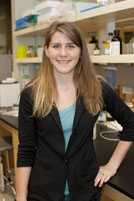Participants, 2012-2013
Laura Youngblood
 How does genetic background affect the effect the activity of the EGFR pathway and subsequent eggshell phenotype in Drosophila melanogaster?
How does genetic background affect the effect the activity of the EGFR pathway and subsequent eggshell phenotype in Drosophila melanogaster?
Genetic variation between individuals can result in variation in the phenotypic effects associated with a particular mutation. Understanding the effects of genetic background can be important in trying to diagnose and properly treat human disease, as different patients may present with variations in disease severity and may also respond differently to a particular treatment regimen. I will use the fruit fly, Drosophila melanogaster, as a model system to explore the effects of genetic background on the expression of mutations in the Epidermal Growth Factor Receptor (EGFR) pathway. The EGFR pathway is critical for the patterning of the Drosophila egg chamber and the formation of the dorsal appendages, which are structures on the eggshell that help deliver oxygen to the developing embryo. In this study, I will examine the effects of two different genetic backgrounds, Oregon-R and Samarkand, on the expression of mutations that effect eggshell patterning and the anterior-posterior placement of the dorsal appendages. I will also examine markers of EFGR pathway activation early in eggshell patterning to try and understand which step in the pathway is being affected by differences in genetic background.
Stephanie Pace
 Does the variation in the orthodenticle regulatory region have an effect on between-species gene expression in Drosophila?
Does the variation in the orthodenticle regulatory region have an effect on between-species gene expression in Drosophila?
Evolutionarily important genetic variation can be broadly classified in two ways; mutations in the coding region of a gene may affect the function of the encoded protein, while changes to regulatory regions of DNA may alter the timing, place or level of expression of a gene. In this study I will examine regulatory region variants that may affect early embryonic patterning in Drosophila species. Previous research has shown that there is extensive within-species variation in the regulatory region of the Drosophila melanogaster orthodenticle gene, which is required for the development and patterning of the head. This variation alters the expression domain of orthodenticle. Furthermore, this same regulatory element shows inter-species variation between D. melanogaster and its sibling species D. simulans. I will examine otd expression in Drosophila simulans in comparison to expression in Drosophila melanogaster to determine how the regulatory variation affects gene expression. Additionally, I will determine the extent of within-population genetic variation of the D. simulansregulatory element. These experiments will aid in our understanding of how genetic variation leads to phenotypic change between species.
Roya Hossaini
 How does nutritional variation affect maternal fecundity, yolk protein production and embryonic patterning?
How does nutritional variation affect maternal fecundity, yolk protein production and embryonic patterning?
An organism’s phenotype is determined by its genotype in addition to environmental factors. One environmental factor that has been shown to have a large impact on phenotype is nutrition. Maternal nutrition is particularly important since the effects of nutritional deficiencies can possibly affect not only the mother but also her offspring. In this study I will examine the effect of variation in fructose levels on various maternal and embryonic traits in Drosophila melanogaster. Increased and decreased fructose levels will be examined for effects on maternal fecundity, measured in an egg-laying assay, and maternal production of yolk protein, a gene product that is deposited into eggs during oogenesis. I will measure transcriptional variation in the yolk protein gene by quantitative reverse-transcriptase PCR. Finally, because early Drosophila embryonic development is dependent upon maternal mRNAs and proteins that are present in the egg, I will examine the effects of variation in fructose levels on embryonic patterning on the expression of segmentation pathway genes. This study will provide insight into the effects of nutritional variation on maternal and embryonic trait variation.
Jana Soares, Melissa Olivares, and Cristina Alvarado

 What are the effects of naturally occurring and synthetic cardioprotective compounds on macrophage function?
What are the effects of naturally occurring and synthetic cardioprotective compounds on macrophage function?
Atherosclerosis, the cause of coronary heart disease, is major cause of morbidity and mortality, as well as an economic burden, of developed countries. Although atherosclerosis is an inflammatory syndrome, the exact nature of the immune responses that result in coronary heart disease have yet to be fully elucidated. However, it has been established that macrophages play a dominant and continuous role in the progression of atherosclerosis. Our lab is interested in studying the effects of cardioprotective compounds on macrophage functions in order to develop a better understanding of the role of macrophages in atherosclerosis and to aid in the design and development of compounds that may serve to prevent the development of coronary heart disease. To this end we are currently investigating polyphenolic compounds found in red wine, such as trans-resveratrol, that have been suggested to be cardioprotective. Our goal is to elucidate the effects of such compounds on  macrophage phagocytosis, cytokine/chemokine production, reactive oxygen/nitrogen species production and foam-cell development. We also are investigating a number of synthetic variants of resveratrol and possible synergistic effects of resveratrol and other reported cardioprotective compounds such as those from olive oil.
macrophage phagocytosis, cytokine/chemokine production, reactive oxygen/nitrogen species production and foam-cell development. We also are investigating a number of synthetic variants of resveratrol and possible synergistic effects of resveratrol and other reported cardioprotective compounds such as those from olive oil.

